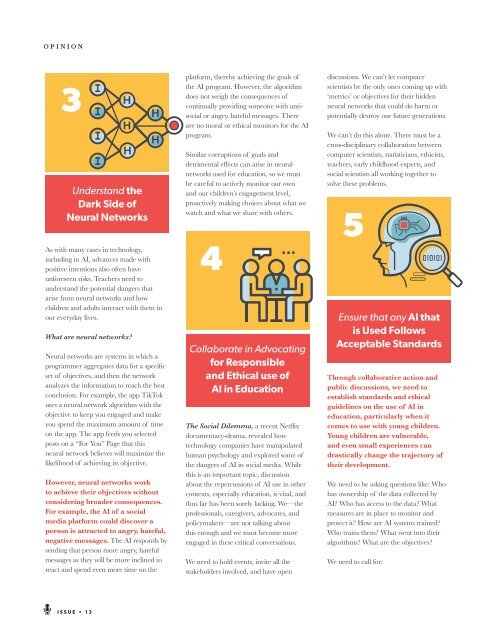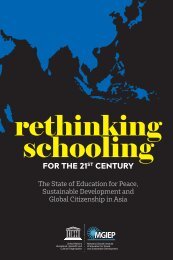The Blue DOT Issue 13
Reimagining Education: Beyond the Rhetoric
Reimagining Education: Beyond the Rhetoric
You also want an ePaper? Increase the reach of your titles
YUMPU automatically turns print PDFs into web optimized ePapers that Google loves.
OPINION<br />
3<br />
Understand the<br />
Dark Side of<br />
Neural Networks<br />
As with many cases in technology,<br />
including in AI, advances made with<br />
positive intentions also often have<br />
unforeseen risks. Teachers need to<br />
understand the potential dangers that<br />
arise from neural networks and how<br />
children and adults interact with them in<br />
our everyday lives.<br />
What are neural networks?<br />
Neural networks are systems in which a<br />
programmer aggregates data for a specific<br />
set of objectives, and then the network<br />
analyzes the information to reach the best<br />
conclusion. For example, the app TikTok<br />
uses a neural network algorithm with the<br />
objective to keep you engaged and make<br />
you spend the maximum amount of time<br />
on the app. <strong>The</strong> app feeds you selected<br />
posts on a “For You” Page that this<br />
neural network believes will maximize the<br />
likelihood of achieving its objective.<br />
However, neural networks work<br />
to achieve their objectives without<br />
considering broader consequences.<br />
For example, the AI of a social<br />
media platform could discover a<br />
person is attracted to angry, hateful,<br />
negative messages. <strong>The</strong> AI responds by<br />
sending that person more angry, hateful<br />
messages as they will be more inclined to<br />
react and spend even more time on the<br />
platform, thereby achieving the goals of<br />
the AI program. However, the algorithm<br />
does not weigh the consequences of<br />
continually providing someone with antisocial<br />
or angry, hateful messages. <strong>The</strong>re<br />
are no moral or ethical monitors for the AI<br />
program.<br />
Similar corruptions of goals and<br />
detrimental effects can arise in neural<br />
networks used for education, so we must<br />
be careful to actively monitor our own<br />
and our children’s engagement level,<br />
proactively making choices about what we<br />
watch and what we share with others.<br />
4<br />
Collaborate in Advocating<br />
for Responsible<br />
and Ethical use of<br />
AI in Education<br />
<strong>The</strong> Social Dilemma, a recent Netflix<br />
documentary-drama, revealed how<br />
technology companies have manipulated<br />
human psychology and explored some of<br />
the dangers of AI in social media. While<br />
this is an important topic, discussion<br />
about the repercussions of AI use in other<br />
contexts, especially education, is vital, and<br />
thus far has been sorely lacking. We—the<br />
professionals, caregivers, advocates, and<br />
policymakers—are not talking about<br />
this enough and we must become more<br />
engaged in these critical conversations.<br />
We need to hold events, invite all the<br />
stakeholders involved, and have open<br />
discussions. We can’t let computer<br />
scientists be the only ones coming up with<br />
‘metrics’ or objectives for their hidden<br />
neural networks that could do harm or<br />
potentially destroy our future generations.<br />
We can’t do this alone. <strong>The</strong>re must be a<br />
cross-disciplinary collaboration between<br />
computer scientists, statisticians, ethicists,<br />
teachers, early childhood experts, and<br />
social scientists all working together to<br />
solve these problems.<br />
5<br />
Ensure that any AI that<br />
is Used Follows<br />
Acceptable Standards<br />
Through collaborative action and<br />
public discussions, we need to<br />
establish standards and ethical<br />
guidelines on the use of AI in<br />
education, particularly when it<br />
comes to use with young children.<br />
Young children are vulnerable,<br />
and even small experiences can<br />
drastically change the trajectory of<br />
their development.<br />
We need to be asking questions like: Who<br />
has ownership of the data collected by<br />
AI? Who has access to the data? What<br />
measures are in place to monitor and<br />
protect it? How are AI systems trained?<br />
Who trains them? What went into their<br />
algorithms? What are the objectives?<br />
We need to call for:<br />
EXPLAINABILITY<br />
New tech, including AI,<br />
must be made transparent<br />
& be able to be explained<br />
FAIRNESS<br />
Properly calibrated, AI can<br />
assist humans in making<br />
fairer, more equitable choices.<br />
ROBUSTNESS<br />
As systems are employed<br />
to make crucial decisions,<br />
AI must be secure and robust<br />
TRANSPARENCY<br />
Transparency reinforces trust,<br />
and the best way to<br />
promote transparency is<br />
through disclosure<br />
PRIVACY<br />
AI systems must prioritize<br />
and safeguard consumers’<br />
privacy and data rights.<br />
RECOMMENDED RESOURCES<br />
6<br />
“What do babies think?”<br />
TEDx Talk by Alison Gopnik<br />
Professor of Psychology and Affiliate Professor of Philosophy at<br />
the Tolman Hall University of California at Berkeley<br />
https://www.ted.com/talks/alison_gopnik_what_do_babies_<br />
think<br />
Remember Our Priorities<br />
as Early<br />
Childhood Educators<br />
As the result of an increasingly<br />
technologically connected world, citizens<br />
are finding it difficult to effectively exercise<br />
civic responsibilities in relation to global<br />
issues such as climate change, poverty,<br />
conflict, and warfare.<br />
Human capabilities such as ethical<br />
reasoning, persuasion, social<br />
understanding, and empathy will become<br />
more and more prized over the next<br />
decade. <strong>The</strong>se functions will become<br />
differentiators as artificial intelligence and<br />
machine learning start to assume roles<br />
that were previously human tasks. Skills<br />
in emotional intelligence will become<br />
essential to anyone who wants to stay<br />
relevant in their field as automated systems<br />
proliferate.<br />
We may not want our world to<br />
change. We may not be comfortable<br />
holding conversations about<br />
artificial intelligence. However, if<br />
we ignore AI we will not be able<br />
to respond appropriately as AI<br />
conversations and application<br />
in education increase. Artificial<br />
intelligence, neural networks, and<br />
machine learning could be extremely<br />
powerful and effective tools for<br />
educators and students alike, but<br />
without diligent commitment<br />
to ensuring these systems are<br />
explainable, fair, robust, transparent,<br />
and protective of privacy, the harm<br />
they could cause may very easily<br />
outweigh the good. We must get<br />
engaged and proactive on these<br />
topics immediately as educational AI<br />
is just starting to take its first steps.<br />
Much like teaching a young child, the<br />
choices we make now at the start will<br />
have vast repercussions down the line. It’s<br />
our duty to ensure those choices are wise,<br />
measured, and point us towards a better<br />
and more secure future.<br />
“An Imminent Threat from Artificial Intelligence”<br />
TEDx Talk by Aidan Gomez<br />
Doctoral student of machine learning at the University of<br />
Oxford https://www.ted.com/talks/aidan_gomez_an_<br />
imminent_threat_from_artificial_intelligence<br />
OPINION<br />
ISSUE • <strong>13</strong><br />
1 9

















